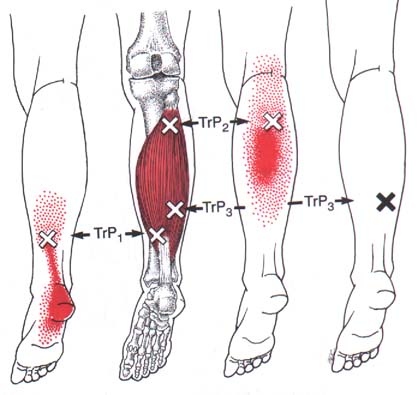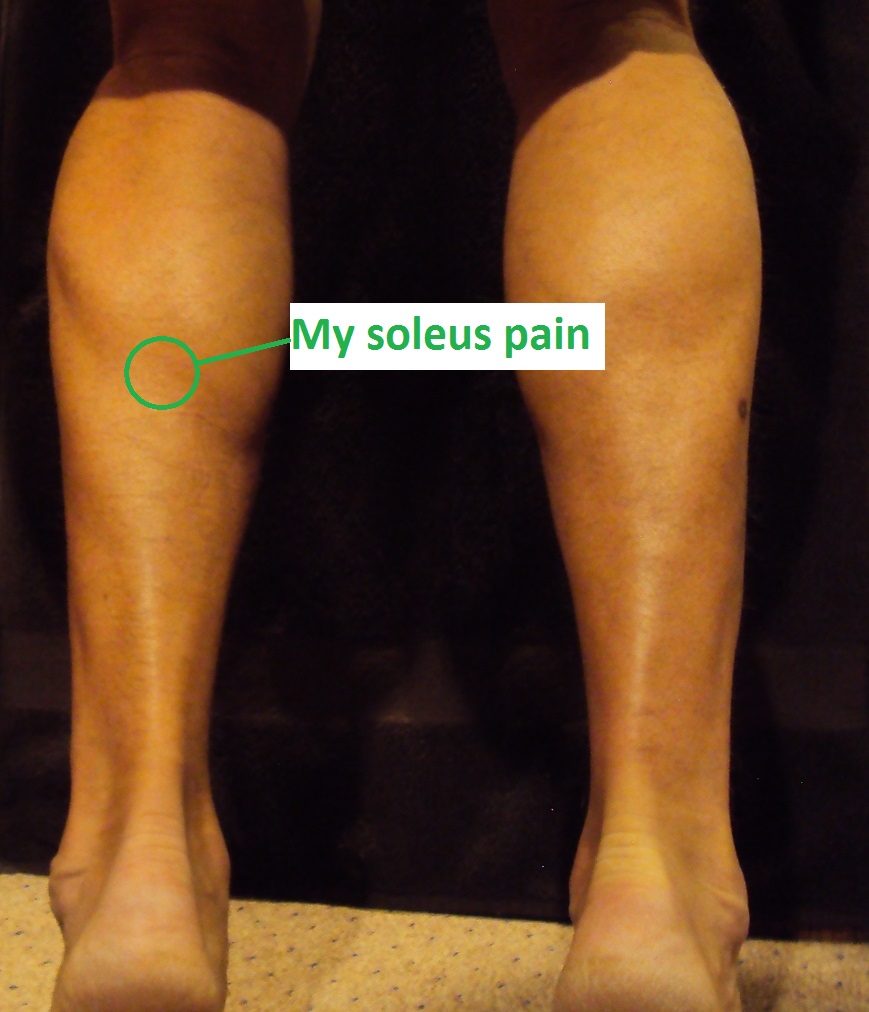
This week’s Muscle Monday will profile and highlight the soleus muscle. I’ll highlight the actions, associated problems, self-care techniques and some trivia about the soleus.
What is it and where is it?
- Today we are going to take an in depth look at the soleus muscle. The soleus lies in the lower leg below the knee and is responsible for plantar flexing the ankle. If we are standing and raise up on our toes, we are plantar flexing. It partners up with the gastrocnemius to form what is called the “triceps surae” that attaches to the thick, strong Achilles tendon. However, while the gastrocnemius has the classic two bulky heads that we think of with “killer calves”, the soleus lies underneath the gastrocnemius and is visible both medially and laterally as it is wider than the gastrocnemius lower in the leg.
- It is sometimes called the “second heart” [1]because as it contracts it plays an important role in returning blood to the heart. Have you ever seen those videos on extended plane flights where they have you doing ankle pumps to keep swelling at bay in your lower legs? You are activating your soleus muscle when you do that.
- The soleus attaches to both the tibia and fibula close to the knee and then to the calcaneus or heel via the Achilles tendon.
What does it do?
- The important thing to note about the soleus is that is does not cross the knee joint, only the ankle joint, thus it is not responsible for flexing or bending the knee.
- Because it works in conjunction with the gastrocnemius it carries a big load and is a large propeller as we walk and move.
- Due to both the gastrocnemius and soleus converging together into the Achilles tendon you can’t talk about the soleus without also thinking about the Achilles tendon. This is vitally important because when it comes to jumping and sudden increased force such as playing basketball or volleyball the Achilles tendon can often be quite susceptible and in worse case scenarios can rupture. Once there is a complete rupture of the Achilles tendon the soleus can no longer do its job of plantar flexing the ankle because a vital part of the kinetic chain has been compromised.
What problems are associated with the soleus?
- Well, the biggest one is the Achilles tendon issue. Because the Achilles tendon is largely avascular, meaning it does not have abundant blood flow, if the gastrocnemius and soleus become compromised for any reason, the Achilles tendon can begin to suffer.
- The soleus can develop trigger points and hypertonicity/tightness which can lead to dysfunction and create stress on another structure further down the kinetic chain below the ankle. Yes, it can be a player in plantar fascia pain and foot pain.

The “x” marks trigger points and red areas are where the referred pain is felt in active trigger points in the soleus muscle. On the left note the referred pain that mimics plantar fascia pain! - Running hills or hiking steep hills or mountains can lead to sudden overload on the soleus and can be affected going both uphill and downhill. As you go steeply uphill on any incline which causes you to be on your toes you will be creating a situation where the soleus is required to do much more work. Conversely as you come downhill the soleus acts as a brake for the ankle complex and performs eccentrically, where it is lengthening while still contacting. This is the type of contraction that creates really sore muscles or delayed onset muscle soreness (DOMS) which you feel roughly 24 hours after the activity.
- At this point I’d like to make an interesting observation that I came across this past summer. I did quite a bit of trail hiking and backpacking in Colorado this summer. I switched from a leather, high top hiking boot to a below the ankle trail runner. I realized that if you are using low cut shoes or boots you will put a lot more stress on the musculature below the knee, especially as you are descending down hills. If you use a boot or shoe that is above the ankle you’ll find that more of the stress gets put on the hips and quads. So pick your poison, sore quads and hips or sore calves.
- Overload in the form of overtraining or too much activity without allowing the body to adapt and recover can also lead to a perfect storm for an injury in the soleus.

The green circle was where I had pinpoint pain like a bolt being turned into my leg!
I encountered this very problem this past spring and I’ve seen it in numerous clients. For me, I had done a hike with steep climbing and downhill on a Friday after a short break from hiking. Then starting on Tuesday I ran three days in a row. While heading out for what seemed like a fairly benign longer run on a warm Thursday I began to notice some tightness in my calf after about four miles. I stopped and did some self massage and some controlled stretches and continued on. After another mile it became so severe that I could barely walk. I even tried to “run through it” and realized I was being a complete fool because I tell my clients to never, ever do that! Luckily I had my phone and called a friend to come bail me out.
What I thought was a strain or muscle pull turned out to be some cramping that was occurring. And it was also at an area where the gastrocs and soleus came together as they begin to form the musculotendinous junction. But I didn’t realize this until the following Tuesday when I went to see my massage therapist. We both came to the conclusion that there wasn’t any tearing but a deep spasm. It felt like someone was turning a thumb sized bolt directly into my calf.
What can help with pain or dysfunction?
- Overuse or a sudden increase in activity can contribute to problems with the soleus. If you are training for an event or adding a lot of volume make sure you follow the “10% rule” in your training plan. That is, you are not adding more than 10% of volume to each weeks mileage as you build, especially during the “base” phase of your training plan.
- Recovery and rest is vitally important along with good nutrition and hydration. To aid in quickening recovery you can use a light massage sequence like below.
- Negative calf raises quite often are a recommended stretch by physical therapists, especially in dealing with achilles tendon injuries. This employs my favorite type of stretch, the eccentric or lengthening type of contraction of which I highly favor. I recommend this over a static type of stretch.
- Implementing a deeper self massage technique can be helpful after onset of deeper cramping symptoms. Here is a technique targeted toward a deeper muscle, tibialis posterior, for posterior shin splints but is still very effective for soleus pain because you will be working through both the gastrocnemius and soleus to access the deeper muscle.
- While research goes back and forth regarding how much hydration comes into play with soft tissue injuries, I feel it is important to gauge fluid intake so that you are making sure you remain hydrated.
The soleus can quite often be overlooked as a contributor to many different conditions regarding the lower leg and even foot pain. But once it comes into play, it can be stubborn in resolving itself without a little bit of help and TLC. In my case it came on suddenly and lasted about two weeks before I could engage in full activity without thinking about and compensating my running form. But it can also linger if not given the proper attention and care once a problem arises. Listen to your body and always consult a health care professional if things don’t quickly get better on their own.
[1] Trail Guide to the Body, 3rd edition, Books of Discovery, Andrew Biel
This is was excellent. Thank you.